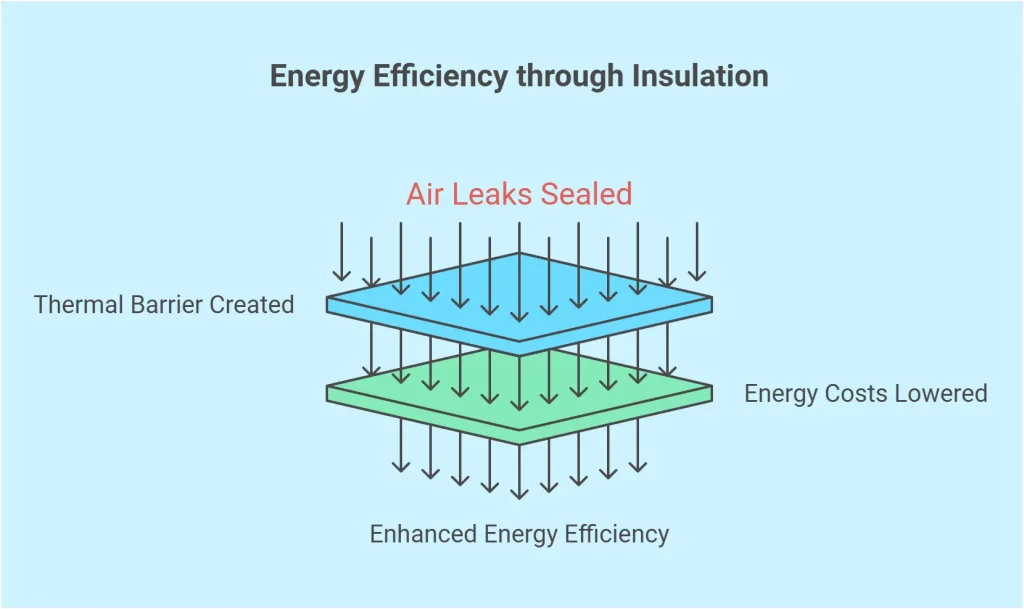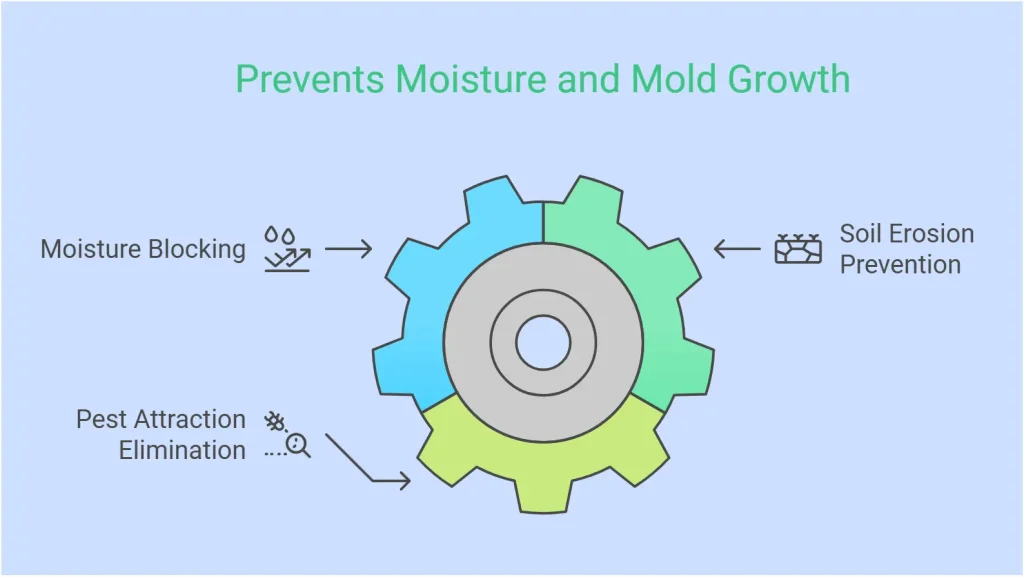Your crawl space is like the unsung hero of your home—it quietly supports the structure while also hiding pipes, wires, and ducts. However, without proper insulation, it can turn into a nightmare of drafts, moisture, and rising energy bills. Insulation acts as a barrier to keep out the bad stuff (think cold air and moisture) while maintaining the good stuff (like warmth and dry air).
By preventing temperature fluctuations, moisture intrusion, and structural damage, insulation transforms the crawl space from a neglected area into a well-protected and functional component of your house.
1. Improves Energy Efficiency & Air Quality

Pairing fiberglass batt insulation with a crawl space vapor barrier ensures the area remains moisture-free and thermally efficient.
Crawl space insulation reduces heat transfer between the crawl space and the living areas above.
During winter, it retains heat inside your home, and in summer, it keeps the hot air out. Energy-efficient homes are more attractive to buyers, as they promise lower utility costs and environmentally friendly features.
Crawl spaces often allow contaminants like mold spores, dust, and radon gas to enter the home through air gaps. Insulation acts as a barrier, reducing the flow of these pollutants into your living space.
Benefits:
- The overall crawl space encapsulation also prevents crawl space contaminants, like dust and pest debris, from entering living spaces.
- Seals air leaks, reducing drafts and energy loss. Creates a thermal barrier, keeping the home warmer in winter and cooler in summer.
- Lowers indoor humidity levels, making the home more comfortable.
- Reduces respiratory issues caused by allergens and poor air quality.
- Lowers heating and cooling costs by up to 20%. Prospective buyers see encapsulated homes as modern and energy-efficient, increasing the property’s marketability.
Example: Sealing and insulating the crawl space floor prevents the “stack effect,” where air from the crawl space is drawn into the home, improving overall air quality.
2. Prevents Moisture and Mold Growth

Insulation materials, when paired with moisture barriers, create a protective shield that prevents damp air from seeping into the crawl space. Unsealed crawl spaces allow cold air to flow into your home during winter and warm air during summer, leading to higher energy bills. Insulation helps block these air leaks.
How It Works:
Spray foam insulation fills gaps and cracks, sealing air leaks. In vented crawl spaces, vent covers block external airflow, complementing the insulation’s effectiveness.
Encapsulation systems use insulation in combination with vapor barrier installation to create a sealed environment. As a result, you will see the significant reduction in drafts and energy loss
Benefits:
- Blocks moisture that causes wood rot, weakening floor joists and beams.
- Prevents soil erosion and foundation settlement by controlling groundwater.
- Eliminates conditions that attract termites and other pests.
Example: Spray foam insulation forms an airtight seal, blocking water vapor and ensuring that the crawl space remains dry and mold-free. Encapsulation reassures buyers that the home’s foundation and structure are well-maintained and protected. Read more on how does Crawl Space Insulation work.
3. Enhances Structural Integrity
Insulation prevents condensation on metal pipes, wooden beams, and foundation walls, reducing the risk of corrosion, rot, and structural weakening.
Benefits:
- Extends the lifespan of foundational elements.
- Prevents costly repairs caused by structural damage over time.
Example: Insulating the rim joist area (where the foundation meets the floor) prevents moisture-related wood rot and maintains the stability of the flooring system.
4. Protects Pipes and HVAC Systems
Crawl spaces often house pipes, ductwork, and HVAC components, all of which are vulnerable to extreme temperatures. Insulation safeguards these systems from freezing or overheating.
How It Works:
- Insulation around pipes prevents freezing during cold weather, which can lead to costly repairs.
- Insulated ductwork minimizes energy loss, ensuring efficient heating and cooling distribution.
Benefits:
- Reduces the risk of burst pipes and water damage.
- Saves money on repairs and replacements.
Example: Fiberglass or foam pipe insulation combined with crawl space wall insulation prevents temperature drops that could freeze plumbing lines.
5. Reduces Maintenance Costs
Crawl space encapsulation can significantly increase a home’s value by improving energy efficiency, protecting structural integrity, enhancing indoor air quality, and reducing maintenance concerns. Homebuyers view encapsulation as a valuable upgrade, especially in areas prone to moisture-related issues or with older homes. Here’s how encapsulation impacts home value. As a result, your buyers value homes that offer lower operating costs and require minimal upkeep.
Quantifying the Value Increase
| Feature | Estimated Value Increase |
|---|---|
| Energy Efficiency Improvements | $2,000–$5,000 |
| Structural Integrity (Foundation Protection) | $5,000–$15,000 |
| Enhanced Air Quality | $2,000–$7,000 |
| Pest and Moisture Prevention | $2,000–$8,000 |
| Regional Market Appeal (Humid Areas) | Varies by location ($5,000+) |
Total Value Increase: Crawl space encapsulation can add $5,000–$20,000 to a home’s value, depending on its location, size, and market demand.
Case Study: Encapsulation ROI
In Barrie, Ontario, Canada we have asked one of our clients how much he saved after insulating his Interior basement waterproofing service.
| Metric | Details |
|---|---|
| Initial Cost | $7,500 for encapsulation in a 2,000 sq. ft. home |
| Energy Savings | $300 annually (20% savings on $1,500 energy bill) |
| Maintenance Savings | $1,000 annually (avoiding pest control and repairs) |
| Appraisal Value Increase | $10,000 |
| Total ROI in 10 Years | $3,000 in savings + $10,000 appraisal value = $13,000 ROI, almost doubling the initial investment |
6. Reduces Pest Infestations
Insulation closes gaps and creates an inhospitable environment for pests like rodents and insects that thrive in unsealed, damp crawl spaces.
Benefits:
- Keeps pests from nesting and damaging insulation materials or wiring.
- Eliminates the health risks associated with pest infestations.
Example: Closed-cell spray foam insulation not only seals out air but also acts as a deterrent for pests by eliminating entry points.
7. Reduces Noise Transmission
Insulation dampens sound transmission from the crawl space, especially in homes with mechanical equipment like furnaces or water pumps installed in the area.
Benefits:
- Creates a quieter indoor environment.
- Minimizes noise from outside or adjacent rooms.
Example: Adding rigid foam insulation under the subfloor reduces noise from the crawl space, creating a more comfortable living experience.
8. Protects Flooring Above the Crawl Space
Insulating the crawl space keeps the subfloor above it warmer during winter and cooler during summer, reducing wear and tear on flooring materials.
Benefits:
Prevents buckling or warping of hardwood floors caused by temperature and moisture changes.
Adds comfort for residents walking on the floors above.
Example: Proper insulation keeps tile or wood floors comfortable to walk on, even during cold winters, improving overall livability.
9. Adds Usable Storage Space
Insulated and encapsulated crawl spaces stay dry and temperature-controlled, making them suitable for storing items without risk of mold or damage.
Benefits
Maximizes the utility of an otherwise neglected space.
Protects stored items from moisture and pests.
Example: A homeowner in Barrie could use an insulated crawl space to store seasonal decorations or tools without fear of damage from moisture or extreme temperatures.
Homes in colder climates like Barrie see a significant decrease in heat loss when the crawl space is properly insulated, resulting in less strain on HVAC systems. Learn more about Crawl space insulation service in Barrie
10. Enhances Indoor Comfort
Insulation in crawl spaces eliminates cold floors during winter and keeps indoor air temperatures stable, improving overall comfort in your home.
Benefits:
- By sealing gaps and cracks, insulation stops drafts from affecting living areas.
- Proper thermal regulation ensures even temperatures throughout the house.
FAQ
How do I know if my crawl space needs insulation?
If you notice cold floors, musty smells, or high energy bills, your crawl space could benefit from insulation.
Can I insulate my crawl space myself?
Yes, but professional installation ensures the best results and fewer headaches.
What is the best type of insulation for crawl spaces? Spray foam and rigid foam are top choices due to their moisture resistance and high efficiency.
How long does crawl space insulation last?
With proper maintenance, insulation can last 20–30 years or more.
Will insulating my crawl space reduce pests?
Insulation helps seal off entry points, making it harder for pests to invade your home.
Conclusion
Crawl space insulation provides numerous benefits that go beyond just temperature control. It works hand-in-hand with other systems like vapor barriers and encapsulation to protect your home from moisture, pests, and energy inefficiency. Insulation transforms your crawl space into a functional, safe, and energy-efficient part of your home by improving air quality, structural durability, and comfort.
